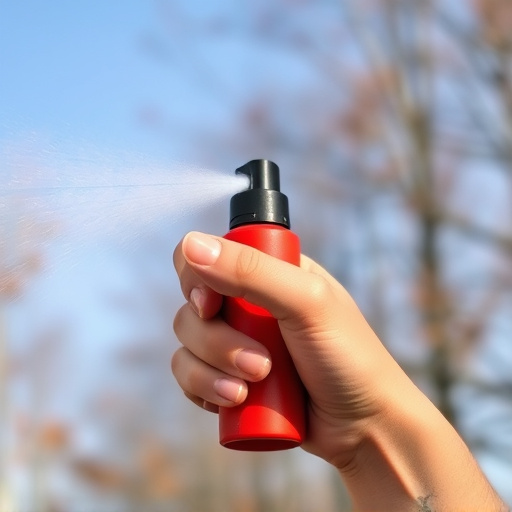Knowing how to treat pepper spray exposure is crucial. Immediately move to fresh air, rinse eyes with water for 15 minutes, wash skin contact areas, and seek medical attention for severe or persistent symptoms. Over-the-counter pain relievers and eye flushing help manage discomfort. Swift treatment minimizes long-term effects, especially for individuals with respiratory conditions. Store pepper spray safely to prevent unauthorized access.
Personal security inflammatory spray canisters are powerful tools designed to deter threats, but understanding their risks and proper usage is crucial. This guide delves into the essential knowledge about pepper spray exposure, from recognizing immediate symptoms to critical emergency steps after contact. Learn effective treatments for skin and eye irritation, along with storage and usage guidelines to ensure safety. Mastering these skills can help you navigate potential risks effectively.
- Understanding Pepper Spray Exposure Risks
- Identifying Symptoms of Exposure Immediately
- Emergency Steps After Coming in Contact
- Effective Treatments for Skin and Eye Irritation
- Storage and Usage Guidelines for Safety
Understanding Pepper Spray Exposure Risks
Understanding Pepper spray exposure risks is crucial for anyone considering self-defense options. While it can be an effective deterrent, the effects of pepper spray can vary greatly depending on factors like concentration, duration of exposure, and individual sensitivity. Inhaling pepper spray can lead to temporary but intense irritation of the eyes, nose, throat, and lungs, making breathing difficult. Skin contact may cause redness, pain, and blistering.
Knowing how to treat pepper spray exposure is essential for minimizing discomfort and potential long-term health issues. If exposed, immediately move to an area with fresh air. Rinse eyes thoroughly with water for at least 15 minutes. For skin contact, gently wash the affected area with soap and water. Seek medical attention if symptoms persist or worsen, especially in cases of severe exposure or if the individual has underlying respiratory conditions.
Identifying Symptoms of Exposure Immediately
If you’ve been exposed to pepper spray, it’s crucial to identify symptoms immediately. Common signs include burning or stinging eyes, difficulty breathing, coughing, and a runny nose. These symptoms can be intense and may develop within seconds of exposure, making prompt recognition vital for effective treatment.
To treat pepper spray exposure, start by moving to an area with fresh air. Remove any contaminated clothing and wash the affected areas with soap and water. Seek medical attention if breathing is severely impaired or if symptoms persist beyond a few minutes. Over-the-counter pain relievers can help manage discomfort, while eye flushing can alleviate eye irritation. How to Treat Pepper Spray Exposure should be a priority for anyone who’s been affected, ensuring swift relief and minimizing potential long-term effects.
Emergency Steps After Coming in Contact
If you come into contact with pepper spray, it’s crucial to take immediate action. The first step is to remove any contaminated clothing or accessories, rinsing thoroughly with water to prevent further exposure. Seek fresh air immediately; if outdoors, move to an open area away from the source of the spray. In enclosed spaces, open windows and doors to ventilate the area.
For eye contact, wash your eyes gently with clean, running water for at least 15 minutes. Do not use soap as it may irritate the skin further. If breathing is difficult, try to move to an area with clean air and apply a cold compress to affected areas. In case of skin exposure, rinse the affected area with water and consider using a mild soap if available. Always remember that seeking medical attention might be necessary, especially for severe reactions or if symptoms persist.
Effective Treatments for Skin and Eye Irritation
If exposed to pepper spray, it’s crucial to know how to effectively treat skin and eye irritation. The first step is to immediately rinse the affected area with plenty of clean water for at least 15 minutes. This helps to dilute and wash away the irritants. For skin irritation, apply a cold compress or ice pack wrapped in a thin cloth to reduce swelling and discomfort. Avoid using ice directly on the skin as it can cause further damage.
In case of eye exposure, seek immediate medical attention. Rinse your eyes with clean water for at least 15 minutes, lifting your eyelids occasionally to ensure thorough cleaning. Do not use any substances other than water, as they may exacerbate the irritation. Wear protective eyewear or a face shield if available, and avoid rubbing your eyes, as this can cause further damage to the sensitive eye tissues.
Storage and Usage Guidelines for Safety
Storing your personal security inflammatory spray canister safely is paramount. Always keep it in a secure, locked location, out of reach of children and unauthorized individuals. Store it away from heat sources, direct sunlight, and extreme temperatures to prevent any damage or degradation of its contents. Ensure the canister is well-ventilated and avoid storing it near food or other flammable items.
When using the spray, follow these safety guidelines. Only deploy it when absolutely necessary for self-defense. Aim for the attacker’s eyes and face, as this area has numerous sensitive nerve endings. Keep a safe distance (approximately 2-3 feet) to ensure you don’t inadvertently harm bystanders. After use, wash your face and hands thoroughly with soap and water, and seek medical attention if needed, especially for eye irritation or breathing difficulties. Learn how to Treat Pepper Spray Exposure symptoms promptly for better safety.
Understanding the risks associated with pepper spray exposure, recognizing symptoms promptly, knowing emergency steps, and following safe storage guidelines are essential. Effectively treating skin and eye irritation can significantly enhance recovery. By adhering to these practices, individuals can ensure their safety and reduce the impact of pepper spray encounters, ultimately empowering them to handle such situations confidently. When it comes to personal security, being prepared makes all the difference.
